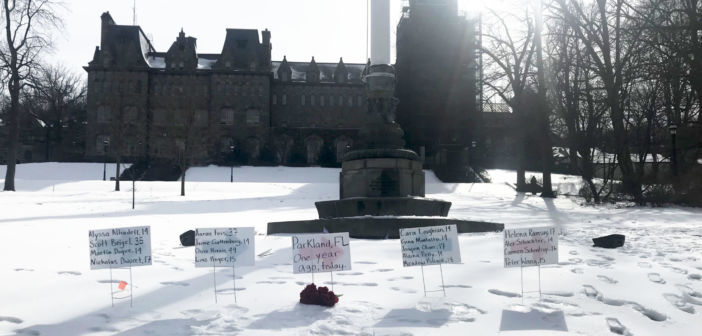Feb. 14, 2018. Valentine’s Day.
A day that should’ve been like any other. A day that should’ve been characterized by love, generosity and gratitude. Instead, it was a day immortalized by hate, loss and tragedy.
On Feb. 14, 2018, the murder of 17 innocent individuals, both students and faculty, occurred at the hands of a teenage gunman at Marjory Stoneman Douglas High School in Parkland, Florida.
Although it is one year later, the recovery for most is far from over.
Hailey Stark, a high school senior at the time of the shooting, still remembers vividly every detail of that day.
She was sitting in History of the Holocaust class, and everyone was taking turns presenting their projects on hate groups. It wasn’t until about 2:30 p.m. that she heard the sound of gunshots start to echo in the hallways.
“At first I thought it was a drill, we all thought it was a drill,” Stark said. “I remember texting my friends, all of us convinced it wasn’t real, so I just relaxed in my seat.”
However, when minutes went by and the sound of the gunshots grew closer and closer, she knew her whole world was about to change.
Suddenly, bullets started pouring into her classroom through the glass window on the door.
“Me and my friend ran to a metal computer cart that was diagonal from the door and hid behind it,” Stark said.
Over the deafening sound of bullets filling the classroom and her head ducked behind the cart, Stark called 911 and frantically texted her friends and family.
“I remember looking down and covering my ears, but once when I looked up, I saw that the girl next to me was shot in the head, she was bleeding everywhere,” Stark said. “The boy next to her was shot in the stomach and the five people next to him were all wounded.”
According to Stark, after what felt like hours, the SWAT team barged into the classroom and started yelling orders at her and her classmates. They were told to stand up and put their hands up while the SWAT team checked them for weapons.
After the SWAT team told them they could leave, Stark said she remembers grabbing her friend’s hand and running out of the building.
“We just started sprinting, passing dead bodies laying in the hallway and blood everywhere,” Stark said. “A lot of people were crying, but because I was in such a state of shock, I still wasn’t processing what was going on.”
Later at home, while Stark was changing out of her clothes, she remembers her twin sister pointing out a mark to her on her thigh.
“It turns out I was grazed by a bullet,” Stark said. “I wasn’t bleeding and I didn’t feel it, but a bruise started forming.”
Now that it’s been over a year since the shooting, which has since been named one of the world’s deadliest school massacres, Stark said she thinks a lot differently than she did before that day.
“Every time I go somewhere I always think in my head if something were to happen, where am I going to hide?” Stark said.
Stark, who is now a freshman at the University of Arizona, said when she walks around the campus, she’s no longer glued to her phone and likes to be aware of her surroundings. She said that although now she is constantly looking around, she didn’t do that in the past because she didn’t feel the need to.
Reflecting on the shooting’s impact over the last year, Stark said it definitely changed the way she viewed life.
“I am a different person from it and I look at things very differently,” Stark said. “I still get upset sometimes, but not to the point where I can’t talk about it openly.”
Though the whole country mourned the loss of the 17 people killed that day, some students at Lehigh remember hearing about the passing of people they personally knew who were inside the school.
Adam Samit, ’21, and Zoe Topaz, ’21, lost their camp counselor, Scott Beigel, a geography teacher who was tragically killed after unlocking his classroom door to let students in from the hallway to hide from the gunman.
“Anyone who knew Scott (Beigel) would say that he was an incredible, genuine person,” Samit said. “He had an amazing sense of humor and would take anyone under his wing and look out for them if they needed anything at all. He was a really compassionate guy.”
Topaz said she remembers getting a phone call that day from a camp friend. The friend told her that there had been a shooting at the school that Beigel worked at.
“I remember immediately falling to the floor in front of M&M and just not being able to move for a few minutes because I was so in shock,” Topaz said. “I just genuinely hope that he’s remembered forever as a hero for what he did that day. I’m just really lucky to have known him.”
Samit, who had Beigel as his division leader at Camp Starlight, located in Starlight, Pennsylvania, said Beigel was a camp icon that everyone knew of and admired.
“You never think something like this can affect you,” Samit said. “You see it on the news and usually it’s just names and faces that you don’t recognize, but when it is someone that you know, nothing can prepare you for that kind of shock.”
Soon after the shooting, Lehigh students Sara Boyd, ’21, Chloe Sider, ‘21, and Ryan Bailey, ’21, came together to try to bring as many students to the March for our Lives protest for gun reform being on March 24, 2018 in Washington, D.C.
“Once they announced the march, we knew we had to go to this and that we also needed to get every student we can to come with us,” Boyd said.
Within a day of advertising the trip over social media, calling it ‘Lehigh for our Lives,’ they had gained over 100 signatures from students interested in going to the march.
Overall, they ended up bringing 148 students to the march in D.C., contributing to the over 800,000 people who attended. The event was the largest single-day protest in Washington’s history.
“Once the march came and went, we knew that there was a lot of student activism that was being almost welshed by something but we didn’t know what it was,” Boyd said. “After the march, we knew it was a lot of where do we go from here — how do we not only keep students involved and engaged but also how to recognize that any sort of school shooting or injustice anywhere is not normal.”
SPAC, the Student Political Action Coalition, was the answer to this question.
The club, primarily formed by Boyd, Sider and Bailey, was established last year and intended to give students a platform to approach multiple political issues, not only gun violence. According to its website, SPAC’s mission statement is “empowering youth to claim their civic agency.”
Since its establishment in spring 2018, SPAC has accomplished quite a lot.
Aside from the march and the sign making party held before it in which students were educated about safe protesting in preparation for the march, SPAC also entered and won a social entrepreneurship competition sponsored by T-Mobile and Ashoka, where they received a $2,000 grant and the chance to attend a conference in Seattle to learn how to make SPAC a long-term organization.
In addition, SPAC took around 12 students to protest the nomination of Brett Kavanaugh at the Supreme Court last semester, as well as hosted a week-long “get out the vote” initiative prior to the midterm elections in November. Besides giving around 80 students rides to the polling places, SPAC hosted midterm panels before and after the election to go over logistics.
“It was definitely a week of craziness, but the absolute best feeling in the world was looking at the voter turnout increase form previous midterm election to this one,” Boyd said.
One of SPAC’s biggest accomplishment over the past year, however, is its establishment as a nonprofit organization. According to Boyd, SPAC has a team of lawyers in New York and Washington, D.C. who help them with the paperwork and financial aspects of this ordeal.
Boyd said the main goal is to mirror SPAC’s model of student activism on different college campuses. She said SPAC is looking into opening SPAC chapters at universities all over the United States.
Reflecting on the entire year since the Parkland shooting, Boyd said she thinks that although political activism might have increased since then, the fight for a safer future in terms of gun regulation is far from over.
“When the Parkland shooting happened, for the first time in my memory, these students were speaking out almost immediately about how ridiculous it was that that weapon was able to get into the hands of that student and they were immediately challenging politicians and rallying students,” Boyd said. “The shooting marked a turning point for, at the very least, youth activism on this point.”
Stark said in order to prevent more school shooting from happening, she thinks there needs to be extreme background checks for people that want to purchase a firearm as well as heightened security in schools.
“Schools don’t want to spend that kind of money to put all these security measures in place because they don’t think something will happen, but as I know from my experience, it easily could,” Stark said. “Every school just needs to spend a little more money.”
Boyd said she thinks the minimum age to buy a firearm should be raised to 21 years old, that there should be a mandatory three-day waiting period to buy any type of firearm and that the government should implement a buy back program in which people can responsibly turn over weapons they don’t want any more so they don’t sit around.
“I’m never gonna say guns shouldn’t exist or be outlawed, people like to hunt and shoot,” Boyd said. “Responsible gun owners are never the problem here.”
SPAC held a memorial on Thursday at the university front lawn to commemorate the 17 victims of the Parkland shooting.






Comment policy
Comments posted to The Brown and White website are reviewed by a moderator before being approved. Incendiary speech or harassing language, including comments targeted at individuals, may be deemed unacceptable and not published. Spam and other soliciting will also be declined.
The Brown and White also reserves the right to not publish entirely anonymous comments.